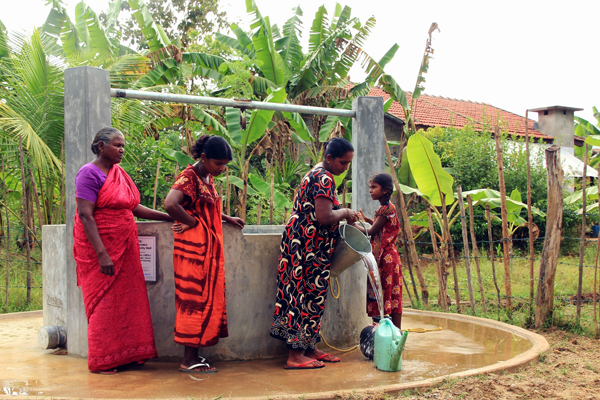Providing Fresh Water to Weligahakandiya Residents in Batticaloa District
Water is a precious resource in Sri Lanka’s dry zone. As most rural areas are not linked to pipe borne water, families usually obtain water from available sources including wells, rivers and irrigation tanks. The village of Weligahakandiya in Batticaloa district is no exception. The community in this conflict affected village depend mainly on small dug wells and tube wells to obtain water for their daily needs. With funding from the “Improving Living Conditions in Returnee Areas of Sri Lanka through Housing“ project, a community well was constructed in the village, which is now providing fresh water to 15 households throughout the year. Altogether, over 37 families will benefit from this initiative, particularly when water is scarce during the dry season.
Weligahakandiya village is located in Koppavely Grama Niladhari division of the Eravurpattu Divisional Secretariat (DS) division in Batticaloa. The village is located about a kilometre from the main A5 road and consists of 57 families. Agriculture, fishing and daily wage labour are the main livelihoods of the residents. Farmers cultivate rice paddy with water from the Weligahakandiya and Panichaiyadithakulam irrigation tanks while fishermen use the tanks to catch fish. Many residents undertake casual wage labour to make ends meet.
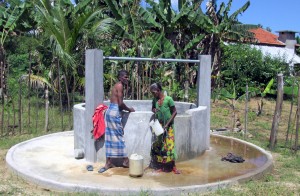
New well constructed in Weligahakandiya village.
Due to the intensification of the conflict in the East from the 1990’s to 2007, the Weligahakandiya residents were displaced on multiple occasions. The families moved to safer areas in Batticaloa district, including the town of Chenkalady where they lived in Displaced Persons Camps and with host families. In mid-2007, with the end of hostilities in the Eastern Province, the families returned to their village. As the conflict had damaged housing and community infrastructure, they faced many challenges including the lack of permanent shelter, sanitation, electricity, fresh water and regular income sources.
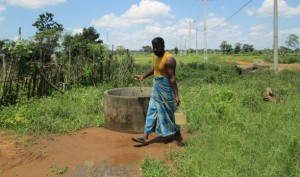
A small dug well used by the Weligahakandiya community to collect fresh water.
The human-elephant conflict is a challenge faced by many farmers in the area. Obtaining fresh water is also a serious issue in Weligahakandiya as there is no pipe borne water supply network. The residents collect water from three small dug wells and two tube wells in several locations. However, these wells do not provide water throughout the year as they dry up during periods of drought.
As the families in the village lack adequate financial resources, they were unable to construct a well deep enough to obtain year round water supply resulting in hardship during the dry season.
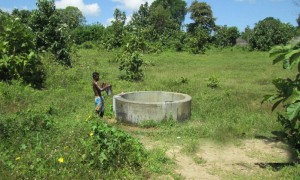
A small dug well used by the Weligahakandiya community to collect fresh water.
The Improving Living Conditions in Returnee Areas of Sri Lanka through Housing project is a housing reconstruction initiative providing support to returning Internally Displaced Persons in the North and East of Sri Lanka. Funded primarily through a grant of € 11.8 million by the European Union, donor partners include the Australian Government and Swiss Agency for Development and Cooperation. From 2013-2014, 36 families were supported in Weligahakandiya to construct permanent homes with funding from this project. In addition to housing, the project also supported communities to construct small community infrastructure facilities in order to facilitate holistic village development.
When the project commenced in Weligahakandiya in 2013, a Settlement Improvement Planning Workshop was conducted by UN-Habitat to identify the priority issues of the community. The community members identified the need for water supply schemes including community wells for families to access fresh water more easily. Hence, the construction of a deep dug well was selected for funding through the project.
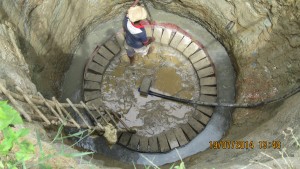
Construction of the new well in progress.
In March 2014, funding was provided to build the community well in a strategic location which would benefit a number of families with easy access to potable water. The location was identified by the community based on the availability of a high water table throughout the year. The land was generously provided by one of the senior residents called Velliyar Mama and the Eravurpattu Divisional Secretary assisted in regularizing the 10 perch land area for the construction of the well. As UN-Habitat follows a participatory process of project implementation, the construction work was entrusted to a Community Based Organisation, the Rural Development Society (RDS) of Koppavely through a community contract, following a rigorous selection process. With a grant of LKR.483,000, the RDS commenced work on the well construction in March 2014. Technical assistance including the design of the well, preparation of the bill of quantities and advice on selecting building materials was provided by UN-Habitat. Skilled construction workers were hired by the RDS to dig the well and construct the appurtenant components.
Mr. Arumugam, the RDS President, discussing the initiative said “This is the first time our organisation managed the construction of a community well. We have learned good management practices through this project, including obtaining competitive bids for building materials and skilled labour. Careful planning and regular monitoring helped us to complete the project within the specified time period”.
The completed well is 8 feet in diameter and 27 feet deep. It has been constructed using cement-sand blocks. The CBO and the masons were trained by the UN-Habitat technical team on the incorporation of standard structural and safety components including reinforced column and apron construction, casting tie beams every 5ft, 3ft high external wall and rung ladder construction.
The construction of the well was completed in January 2015 and the Weligahakandiya residents are now using the well for their daily water needs. A resident of the village stated “It is really useful to have this well close by. We use it daily to collect fresh water for drinking and for other domestic chores.”
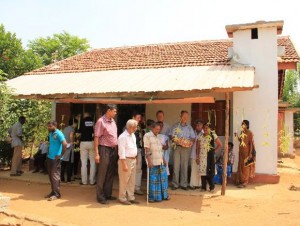
A permanent house constructed with funding from the project in Weligahakandiya during the house warming ceremony by the EU delegation in 2014.
The Grama Niladhari Officer stated. “The donors and UN-Habitat have helped the residents to fulfil some of their basic needs. These include building permanent homes and a community well to obtain fresh water. By involving the community in this project, knowledge on good construction and management practices have been shared with us for future initiatives”.
The “Improving Living Conditions in Returnee Areas of Sri Lanka through Housing” project is being implemented from January 2013 to June 2015 in the districts of Killinochchi, Mullaitivu and Mannar in the North and Batticaloa in the East. The project is supporting the construction of 4,600 houses and a number of infrastructure initiatives including 12 preschools, 14 community centres, 17 wells and the rehabilitation of approximately 38 km of internal access roads.

